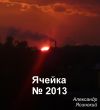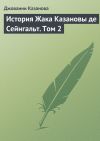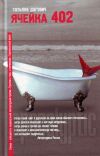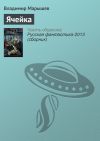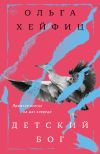Текст книги "Я, паразит"

Автор книги: Пьер Кернер
Жанр: Медицина, Наука и Образование
Возрастные ограничения: +18
сообщить о неприемлемом содержимом
Текущая страница: 10 (всего у книги 11 страниц)
Библиографические ссылки по главам
ГЛАВА I
БИОГРАФЫ ЧЕРВЯ-СОЛИТЕРА

Основное справочное издание по данной теме:
Grove, D. I. (1990). A History of Human Helminthology. C.A.B. International.
Общие сведения о паразитах человека, червях, со схемами их жизненных циклов:
Cours de Parasitologie-Mycologie – Université Numérique Francophone des Sciences de la Santé et du Sport: http://campus.cerimes.fr/parasitologie/liste-2.html.
Яйца червя-солитера в копролитах акул:
Dentzien-Dias, P. C., Poinar, G., Jr., de Figueiredo, A. E. Q., Pacheco, A. C. L., Horn, B. L. D., & Schultz, C. L. (2013). Tapeworm Eggs in a 270 Million-Year-Old Shark Coprolite. PLoS ONE, 8(1), e55007. doi: 10.1371/journal.pone.0055007.
Следы паразитов в мумиях:
Bruschi, F., Masetti, M., Locci, M. T., Ciranni, R., & Fornaciari, G. (2006). Short report: cysticercosis in an Egyptian mummy of the late Ptolemaic period. Am J Trop Med Hyg, 74(4), 598–599. doi: 10.4269/ajtmh.2006.74.598.
Nezamabadi, M., Mashkour, M., Aali, A., Stöllner, T., & Le Bailly, M. (2013). Identification of Taenia sp. in a natural human mummy (third century BC) from the Chehrabad salt mine in Iran. J Parasitol, 99(3), 570–572. doi: 10.1645/12-113.1.
История паразитологии:
Cox, F. E. G. (2002). History of Human Parasitology. Clin Microbiol Rev, 15(4), 595–612. doi: 10.1128/cmr.15.4.595–612.2002.
Power, H. J. (2001). History of Parasitology. eLS. doi: 10.1038/npg.els.0003074.
Roncalli Amici, R. (2001). The history of Italian parasitology. Vet Parasitol, 98(1–3), 3–30. doi: 10.1016/S0304-4017(01)00420-4.
Дополнительные сведения о цестодах всего мира:
Caira, J. N. and K. Jensen (eds.). 2017. Planetary Biodiversity Inventory (2008–2017): Tapeworms from Vertebrate Bowels of the Earth., KS.
Scholz, T., Garcia, H. H., Kuchta, R., & Wicht, B. (2009). Update on the human broad tapeworm (genus diphyllobothrium), including clinical rele-vance. Clin Microbiol Rev, 22(1), 146–160. doi: 10.1128/CMR.00033-08.
Старинные труды с изображениями червя-солитера:
Andry, B.-R. N., Baglivi, G., Berger, C., Du, C. C., Fagon, G.-C., Geof-froy, E.-F., & Hartsoeker, N. (1741). De la generation des vers dans le corps de l’homme: De la nature et des especes de cette maladie; des moyens de s’en préserver & de la guérir. Paris: La Veuve Alix.
Paré, A. (1649). The workes of that famous chirurgion Ambrose Parey. London: Printed by Richard Cotes, and Willi Du-gard, and are to be sold by John Clarke.
Tyson, E. (1683). Lumbricus Latus, or a Discourse Read before the Royal Society of the Joynted Worm, Wherein a great Many Mistakes of Former Writers concerning It, are Remarked; Its Natural History from More Exact Observations is Attempted; and the Whole Urged, as a Difficulty against the Doctrine of Univocal Generation. Philosophical Transactions (1683–1775), 13, 113–144.
ГЛАВА II
ПАРАЗИТАРНЫЕ ХИТРОСПЛЕТЕНИЯ

Общие сведения о паразитоидах:
Godfray, H. C. J. (2004). Parasitoids. Curr Biol, 14(12), R456. doi: 10.1016/j.cub.2004.06.004.
Хромосомы-паразиты:
Aldrich, J. C., & Ferree, P. M. (2017). Genome Silencing and Elimina-tion: Insights from a «Selfish» B Chromosome. Front Genet, 8, 50. doi: 10.3389/fgene.2017.00050.
Werren, J. H. (1980). Sex ratio adaptations to local mate competi-tion in a parasitic wasp. Science, 208(4448), 1157–1159. doi: 10.1126/science.208.4448.1157.
Werren, J. H., & Stouthamer, R. (2003). PSR (paternal sex ratio) chro-mosomes: the ultimate selfish genetic elements. Genetica, 117(1), 85–101.
Личинки-солдаты копидосом:
Cruz, Y. P. (1981). A sterile defender morph in a polyembryonic hyme-nopterous parasite. Nature, 294(5840), 446–447. doi: 10.1038/294446a0.
Uka, D., Takahashi-Nakaguchi, A., Yoshimura, J., & Iwabuchi, K. (2013). Male soldiers are functional in the Japanese strain of a polyembryonic wasp. Sci Rep, 3, 2312. doi: 10.1038/srep02312.
Zhurov, V., Terzin, T., & Grbić, M. (2004). Early blastomere determines embryo proliferation and caste fate in a polyembryonic wasp. Nature, 432(7018), 764–769. doi: 10.1038/nature03171.
Самые маленькие осы в мире:
Huber, J. T., & Noyes, J. (2013). A new genus and species of fairyfly, Tinkerbella nana (Hymenoptera, Mymaridae), with comments on its sister genus Kikiki, and discussion on small size limits in arthropods. J Hymenopt Res, 32, 17–44. doi: 10.3897/jhr.32.4663.
Mockford, E. L. (1997). A New Species of Dicopomorpha (Hymenop-tera: Mymaridae) with Diminutive, Apterous Males. Ann Entomol Soc Am, 90(2), 115–120. doi: 10.1093/aesa/90.2.115.
Афелиниды:
Hunter, M. S., & Woolley, J. B. (2001). Evolution and behavioral ecology of heteronomous aphelinid parasitoids. Annu Rev Entomol, 46, 251–290. doi: 10.1146/annurev.ento.46.1.251.
Walter, G. H. (1983). ‘Divergent male ontogenies’ in Aphelinidae (Hymenoptera: Chalcidoidea): a simplified classification and a suggested evolutionary sequence. Biol J Linn Soc, 19(1), 63–82. doi: 10.1111/j.1095–8312.1983.tb00777.x.
Williams, T., & Polaszek, A. (1996). A re-examination of host relations in the Aphelinidae (Hymenoptera: Chalcidoidea). Biol J Linn Soc, 57(1), 35–45. doi: 10.1111/j.1095–8312.1996.tb01694.x.
Галлообразующие осы:
Joseph, M. B., Gentles, M., & Pearse, I. S. (2011). The parasitoid commu-nity of Andricus quercuscalifornicus and its association with gall size, phenology, and location. Biodiversity and Conservation, 20(1), 203–216. doi: 10.1007/s10531-010-9956-0.
Stone, G. N., & Cook, J. M. (1998). The structure of cynipid oak galls: patterns in the evolution of an extended phenotype. Proc R Soc Lond [Biol], 265(1400), 979–988. doi: 10.1098/rspb.1998.0387.
Stone, G. N., Schonrogge, K., Atkinson, R. J., Bellido, D., & Pujade-Villar, J. (2002). The population biology of oak gall wasps (Hymenop-tera: Cynipidae). Annu Rev Entomol, 47, 633–668. doi: 10.1146/annurev. ento.47.091201.145247.
Бактерицидный вирус тли на страже:
Moran, N. A., Degnan, P. H., Santos, S. R., Dunbar, H. E., & Ochman, H. (2005). The players in a mutualistic symbiosis: insects, bacteria, viruses, and virulence genes. Proc Natl Acad Sci U S A, 102(47), 16919-16926. doi: 10.1073/pnas.0507029102.
Moran, N. A., & Dunbar, H. E. (2006). Sexual acquisition of beneficial symbionts in aphids. Proc Natl Acad Sci U S A, 103(34), 12803–12806. doi: 10.1073/pnas.0605772103.
Oliver, K. M., Noge, K., Huang, E. M., Campos, J. M., Becerra, J. X., & Hunter, M. S. (2012). Parasitic wasp responses to symbiont-based defense in aphids. BMC Biol, 10, 11. doi: 10.1186/1741-7007-10-11.
Oliver, K. M., Russell, J. A., Moran, N. A., & Hunter, M. S. (2003). Facultative bacterial symbionts in aphids confer resistance to para-sitic wasps. Proc Natl Acad Sci U S A, 100(4), 1803–1807. doi: 10.1073/pnas.0335320100.
Металл яйцекладов осы:
Polidori, C., García, A. J., & Nieves-Aldrey, J. L. (2013). Breaking up the wall: metal-enrichment in Ovipositors, but not in mandibles, co-varies with substrate hardness in gall-wasps and their associates. PLoS ONE, 8(7), e70529. doi: 10.1371/journal.pone.0070529.
ГЛАВА III
ИСКУССТВО ПАРАЗИТАРНОЙ ВОЙНЫ

Неисчерпаемый источник информации о муравьях:
http://www.myrmecofourmis.fr/.
Две компиляции важнейших статей о муравьях и их паразитах:
Lachaud, J.-P., Lenoir, A., & Hughes, D. P. (2013). Ants and Their Parasites 2013. Psyche: A Journal of Entomology, 2013, doi: 10.1155/2013/264279.
Lachaud, J.-P., Lenoir, A., & Witte, V. (2012). Ants and Their Parasites. Psyche: A Journal of Entomology, 2012, doi: 10.1155/2012/342157.
Методы химической защиты у муравьев:
Bos, N., Sundström, L., Fuchs, S., & Freitak, D. (2015). Ants medicate to fight disease. Evolution, 69(11), 2979–2984. doi: 10.1111/evo.12752.
Brütsch, T., Jaffuel, G., Vallat, A., Turlings, T. C., & Chapuisat, M. (2017). Wood ants produce a potent antimicrobial agent by applying formic acid on tree-collected resin. Ecol Evol, 7(7), 2249–2254. doi: 10.1002/ece3.2834.
Castella, G., Chapuisat, M., & Christe, P. (2008). Prophylaxis with resin in wood ants. Animal Behaviour, 75(4), 1591–1596. doi: 10.1016/j. anbehav.2007.10.014.
Schlüns, H., and Crozier, R. H. Molecular and chemical immune defenses in ants (Hymenoptera: Formicidae). Myrmecological News, 2009, 12, 237–249.
Moreau, S. J. (2013). «It stings a bit but it cleans well»: venoms of Hyme-noptera and their antimicrobial potential. J Insect Physiol, 59(2), 186–204. doi: 10.1016/j.jinsphys.2012.10.005.
Муравьиные туалеты:
Czaczkes, T. J., Heinze, J., & Ruther, J. (2015). Nest etiquette-where ants go when nature calls. PLoS ONE, 10(2), e0118376. doi: 10.1371/journal. pone.0118376.
Farji-Brener, A. G., Elizalde, L., Fernández-Marin, H., & Amador-Vargas, S. (2016). Social life and sanitary risks: evolutionary and current ecological conditions determine waste management in leaf-cutting ants. Proc Biol Sci, 283(1831). doi: 10.1098/rspb.2016.0625.
Акустический миметизм у бабочек:
Barbero, F., Bonelli, S., Thomas, J. A., Balletto, E., & Schönrogge, K. (2009). Acoustical mimicry in a predatory social parasite of ants. J Exp Biol, 212(24), 4084–4090. doi: 10.1242/jeb.032912.
Barbero, F., Thomas, J. A., Bonelli, S., Balletto, E., & Schönrogge, K. (2009). Queen ants make distinctive sounds that are mimicked by a butterfly social parasite. Science, 323(5915), 782–785. doi: 10.1126/science.1163583.
Devries, P., Cocroft, R.B., Thomas, J. (1993). Comparison of acoustical signals in Maculinea butterfly caterpillars and their obligate host Myrmica ants. Biol J Linn Soc, 49(3), 229–238. doi: 10.1111/j.1095–8312.1993. tb00902.x.
Миметизм яиц у палочников:
Goldberg, J., Bresseel, J., Constant, J., Kneubuhler, B., Leubner, F., Michalik, P., & Bradler, S. (2015). Extreme convergence in egg-laying strategy across insect orders. Sci Rep, 5, 7825. doi: 10.1038/srep07825.
Stanton, A. O., Dias, D. A., & O’Hanlon, J. C. (2015). Egg Dispersal in the Phasmatodea: Convergence in Chemical Signaling Strategies Between Plants and Animals? J Chem Ecol, 41(8), 689–695. doi: 10.1007/s10886-015-0604-8.
Поведенческие манипуляции паразитами ритмов хозяина:
Botnevik, C. F., Malagocka, J., Jensen, A. B., & Fredensborg, B. L. (2016). Relative Effects of Temperature, Light, and Humidity on Clinging Behavior of Metacercariae-Infected Ants. J Parasitol, 102(5), 495–500. doi: 10.1645/16-53.
de Bekker, C., Will, I., Hughes, D. P., Brachmann, A., & Merrow, M. (2017). Daily rhythms and enrichment patterns in the transcriptome of the behavior-manipulating parasite Ophiocordyceps kimflemingiae. PLoS ONE, 12(11), e0187170. doi: 10.1371/journal.pone.0187170.
Reece, S. E., Prior, K. F., & Mideo, N. (2017). The Life and Times of Parasites: Rhythms in Strategies for Within-host Survival and Between-host Transmission. J Biol Rhythms, 32(6), 516–533. doi: 10.1177/0748730417718904.
Поведенческий иммунитет:
Daly, E. W., & Johnson, P. T. (2011). Beyond immunity: quantifying the effects of host anti-parasite behavior on parasite transmission. Oecologia, 165(4), 1043–1050. doi: 10.1007/s00442-010-1778-y.
de Roode, J. C., & Lefèvre, T. (2012). Behavioral Immunity in Insects. Insects, 3(3), 789–820. doi: 10.3390/insects3030789.
Flemming, A. (2017). Insect Immunity: Mechanism of adaptive immu-nity found in the fruitfly. Nat Rev Immunol, 17(5), 278–279. doi: 10.1038/nri.2017.44.
Gray, B., Jacobs, A. C., Mora, A. B., & Zuk, M. (2012). Antiparasite behavior. Curr Biol, 22(8), R255-257. doi: 10.1016/j.cub.2012.02.024.
Hamilton, C., Lejeune, B. T., & Rosengaus, R. B. (2011). Trophal-laxis and prophylaxis: social immunity in the carpenter ant Camponotus pennsylvanicus. Biol Lett, 7(1), 89–92. doi: 10.1098/rsbl.2010.0466.
Hart, B. L. (2011). Behavioural defences in animals against pathogens and parasites: parallels with the pillars of medicine in humans. Philos Trans R Soc Lond B Biol Sci, 366(1583), 3406–3417. doi: 10.1098/rstb.2011.0092.
Манипулирование грибами Cordiceps:
Fredericksen, M. A., Zhang, Y., Hazen, M. L., Loreto, R. G., Mangold, C. A., Chen, D. Z., & Hughes, D. P. (2017). Three-dimensional visuali-zation and a deep-learning model reveal complex fungal parasite networks in behaviorally manipulated ants. Proc Natl Acad Sci U S A, 114(47), 12590-12595. doi: 10.1073/pnas.1711673114.
Marikovsky, P. I. (1962). On some features of behavior of the ants Formica rufa L. infected with fungous disease. Insectes Sociaux, 9(2), 173–179. doi: 10.1007/bf02224263.
Иммунная система насекомых:
Gillespie, J. P., Kanost, M. R., & Trenczek, T. (1997). Biological media-tors of insect immunity. Annu Rev Entomol, 42, 611–643. doi: 10.1146/annurev.ento.42.1.611.
Tassetto, M., Kunitomi, M., & Andino, R. (2017). Circulating Immune Cells Mediate a Systemic RNAi-Based Adaptive Antiviral Response in Drosophila. Cell, 169(2), 314–325 e313. doi: 10.1016/j.cell.2017.03.033.
Нематоды-паразитоиды:
Haas, W. (2003). Parasitic worms: strategies of host finding, reco-gnition and invasion. Zoology (Jena), 106(4), 349–364. doi: 10.1078/0944-2006-00125.
Hilsinger, K. C., Anderson, R. A., & Nayduch, D. (2011). Seasonal dyna-mics of Skrjabinoptera phrynosoma (Nematoda) infection in horned lizards from the Alvord Basin: temporal components of a unique life cycle. J Parasitol, 97(4), 559–564. doi: 10.1645/GE-2644.1.
Lee, S. H. (1957). The life cycle of Skrjabinoptera phrynosoma (Ortlepp) Schulz, 1927 (Nematoda: Spiruroidea), a gastric nematode of Texas horned toads, Phrynosoma cornutum. J Parasitol, 43(1), 66–75.
Lee, S. H. (1957). The life cycle of Skrjabinoptera phrynosoma (Ortlepp) Schulz, 1927 (Nematoda: Spiruroidea), a gastric nematode of Texas horned toads, Phrynosoma cornutum. J Parasitol, 43(1), 66–75.
Птицы, при помощи муравьев избавляющиеся от паразитов:
Morozov, N. S. (2015). Why do birds practice anting? Biology Bulletin Reviews, 5(4), 353–365. doi: 10.1134/s2079086415040076.
Revis, H. C., & Waller, D. A. (2004). Bactericidal and Fungicidal Activity of Ant Chemicals on Feather Parasites: An Evaluation of Anting Behavior as a Method of Self-Medication in Songbirds. The Auk, 121(4), 1262–1268. doi: 10.1642/0004-8038(2004)121.
Межвидовой паразитизм у муравьев:
Powell, S., Del-Claro, K., Feitosa, R. M., & Brandão, C. R. (2014). Mimicry and eavesdropping enable a new form of social parasitism in ants. Am Nat, 184(4), 500–509. doi: 10.1086/677927.
Морфологические манипуляции паразитов:
Poinar, G., Jr., & Yanoviak, S. P. (2008). Myrmeconema neotropicum n. g., n. sp., a new tetradonematid nematode parasitising South American populations of Cephalotes atratus (Hymenoptera: Formicidae), with the discovery of an apparent parasite-induced host morph. Syst Parasitol, 69(2), 145–153. doi: 10.1007/s11230-007-9125-3.
Разное:
Stoeffler, M., Maier, T. S., Tolasch, T., & Steidle, J. L. (2007). Forei-gn-language skills in rove-beetles? Evidence for chemical mimicry of ant alarm pheromones in myrmecophilous Pella beetles (Coleoptera: Staphylinidae). J Chem Ecol, 33(7), 1382–1392. doi: 10.1007/s10886-007-9315-0.
von Beeren, C., & Tishechkin, A. K. (2017). Nymphister kronaueri von Beeren & Tishechkin sp. nov., an army ant-associated beetle species (Coleoptera: Haeteriinae: Haeteriinae) with an exceptional mechanism of phoresy. BMC Zoology, 2(1). doi: 10.1186/s40850-016-0010-x.
Witek, M., Barbero, F., & Markó, B. (2014). Myrmica ants host highly diverse parasitic communities: from social parasites to microbes. Insectes Sociaux, 61(4), 307–323. doi: 10.1007/s00040-014-0362-6.
ГЛАВА IV
УБЫТКИ CO-PARASITO™

Саккулина:
Høeg, J. T. (1995). The biology and life cycle of the Rhizocephala (Cirripedia). Journal of the Marine Biological Association of the United Kingdom, 75(03), 517–550. doi: 10.1017/s0025315400038996.
Noever, C., Keiler, J., & Glenner, H. (2016). First 3D reconstruction of the rhizocephalan root system using MicroCT. Journal of Sea Research, 113, 58–64. doi: 10.1016/j.seares.2015.08.002.
Walker, G. (1985). The cypris larvae of Sacculina carcini Thompson (Crus-tacea: Cirripedia: Rhizocephala). Journal of Experimental Marine Biology and Ecology, 93(1–2), 131–145. doi: 10.1016/0022-0981(85)90154-6.
Кастрация паразитом:
Averbuj, A., & Cremonte, F. (2010). Parasitic castration of Buccinanops cochlidium (Gastropoda: Nassariidae) caused by a lepocreadiid digenean in San Jose Gulf, Argentina. J Helminthol, 84(4), 381–389. doi: 10.1017/S0022149X10000052.
Koskella, B., & Lively, C. M. (2009). Evidence for negative frequen-cy-dependent selection during experimental coevolution of a freshwater snail and a sterilizing trematode. Evolution, 63(9), 2213–2221. doi: 10.1111/j.1558–5646.2009.00711.x.
Kuris, A. M. (1974). Trophic Interactions: Similarity of Parasitic Castra-tors to Parasitoids. The Quarterly Review of Biology, 49(2), 129–148. doi: 10.1086/408018.
Ocampo, E. H., Nuñez, J. D., Cledón, M., & Baeza, J. A. (2014). Para-sitic castration in slipper limpets infested by the symbiotic crab Calyp-traeotheres garthi. Marine Biology, 161(9), 2107–2120. doi: 10.1007/s00227-014-2490-y.
Паразиты в глазах:
Seppälä, O., Karvonen, A., & Valtonen, E. T. (2005). Manipulation of fish host by eye flukes in relation to cataract formation and parasite infectivity. Animal Behaviour, 70(4), 889–894. doi: 10.1016/j.anbehav.2005.01.020.
Yano, K., & Musick, J. A. (2000). The Effect of the Mesoparasitic Barnacle Anelasma on the Development of Reproductive Organs of Deep-sea Squa-loid Sharks, Centroscyllium and Etmopterus. Environmental Biology of Fishes, 59(3), 329–339. doi: 10.1023/a:1007649227422.
Трансформация щупалец улиток, на которых паразитирует Leucochloridium:
Ataev, G. L., Babich, P. S., & Tokmakova, A. S. (2013). The study of the sporocyst broodsacs coloring in Leucochloridium paradoxum (Trematoda: Brachylaemidae). Parazitologiia, 47(5), 372–379.
Ataev, G. L., Zhukova, A. A., Tokmakova A. S., & Prokhorova E. E. (2016). Multiple infection of amber Succinea putris snails with sporocysts of Leucochloridium spp. (Trematoda). Parasitol Res, 115(8), 3203–3208. doi: 10.1007/s00436-016-5082-6.
King, K. C., Jokela, J., & Lively, C. M. (2011). Trematode parasites infect or die in snail hosts. Biol Lett, 7(2), 265–268. doi: 10.1098/rsbl.2010.0857.
Leung, T. L., & Poulin, R. (2011). Small worms, big appetites: ratios of diffe-rent functional morphs in relation to interspecific competition in trematode parasites. Int J Parasitol, 41(10), 1063–1068. doi: 10.1016/j.ijpara.2011.05.001.
Podvyaznaya, I. M., & Galaktionov, K. V. (2012). Morpho-functional specialization of the branching sporocyst of Prosorhynchoides borealis Bartoli, Gibson & Bray, 2006 (Digenea, Bucephalidae). J Helminthol, 86(2), 173–184. doi: 10.1017/S0022149X11000137.
Wesołowska, W., & Wesołowski, T. (2014). Do Leucochloridium sporocysts manipulate the behaviour of their snail hosts? Journal of Zoology, 292(3), 151–155. doi: 10.1111/jzo.12094.
Дополнительные ножки у лягушки, подвергшейся атаке паразитов:
Johnson, P. T. J., Sutherland, D. R., Kinsella, J. M., & Lunde, K. B. (2004). Review of the Trematode Genus Ribeiroia (Psilostomidae): Ecology, Life History and Pathogenesis with Special Emphasis on the Amphibian Malformation Problem. Adv Parasitol, 57, 191–253. doi: 10.1016/s0065-308x(04)57003-3.
Изменение цвета растений:
Krischik, V., McCloud, E., & Davidson, J. (1989). Selective Avoidance by Vertebrate Frugivores of Green Holly Berries Infested with a Cecidomyiid Fly (Diptera: Cecidomyiidae). The American Midland Naturalist, 121(2), 350–354. doi: 10.2307/2426039.
Kaiser, W., Huguet, E., Casas, J., Commin, C., & Giron, D. (2010). Plant green-island phenotype induced by leaf-miners is mediated by bacterial symbionts. Proc Biol Sci, 277(1692), 2311–2319. doi: 10.1098/rspb.2010.0214.
Takagi, E., Iguchi, K., Suzuki, M., & Togashi, K. (2012). A seed para-sitoid wasp prevents berries from changing their colour, reducing their attractiveness to frugivorous birds. Ecological Entomology, 37(1), 99-107. doi: 10.1111/j.1365–2311.2011.01340.x.
Клещ, вызывающий вегетарианство:
Commins, S. P., James, H. R., Kelly, L. A., Pochan, S. L., Workman, L. J., Perzanowski, M. S., (…) Platts-Mills, T. A. (2011). The relevance of tick bites to the production of IgE antibodies to the mammalian oligosaccharide galactose-alpha-1,3-galactose. J Allergy Clin Immunol, 127(5), 1286–1293 e1286. doi: 10.1016/j.jaci.2011.02.019.
Commins, S. P., Jerath, M. R., Cox, K., Erickson, L. D., & Platts-Mills, T. (2016). Delayed anaphylaxis to alpha-gal, an oligosaccha-ride in mammalian meat. Allergol Int, 65(1), 16–20. doi: 10.1016/j. alit.2015.10.001.
Джекалоп:
Références et liens dans cet article de SSAFT: http://ssaft.com/Blog/dotclear/index.php?pages/Jackalope.
Гельминтотерапия:
Une page Wikipédia super-complète: https://en.wikipedia.org/wiki/Helminthic_therapy.
Паразиты как биоиндикаторы:
Malek, M., Haseli, M., Mobedi, I., Ganjali, M. R., & Mackenzie, K. (2007). Parasites as heavy metal bioindicators in the shark Carcharhinus dussumieri from the Persian Gulf. Parasitology, 134(Pt 7), 1053–1056. doi: 10.1017/S0031182007002508.
ГЛАВА V
ПАРАЗИТАРНАЯ КАМАСУТРА

Личинки-вуайеристы Meloe:
Vereecken, N. J., & Mahe, G. (2013). Larval aggregations of the blister beetle Stenoria analis (Schaum) (Coleoptera: Meloidae) sexually deceive patrolling males of their host, the solitary bee Colletes hederae Schmidt & Westrich (Hymenoptera: Colletidae). Annales de la Société entomologique de France (N.S.), 43(4), 493–496. doi: 10.1080/ 00379271.2007.10697538.
Единственная статья, которую надо обязательно прочесть:
Zequi Sde, C., Guimaraes, G. C., da Fonseca, F. P., Ferreira, U., de Matheus, W. E., Reis, L. O., (…) Lopes, A. (2012). Sex with animals (SWA): behavioral characteristics and possible association with penile cancer. A multicenter study. J Sex Med, 9(7), 1860–1867. doi: 10.1111/j.1743–6109.2011.02512.x.
Обмен лобковыми вшами между гориллой и человеком:
Reed, D. L., Light, J. E., Allen, J. M., & Kirchman, J. J. (2007). Pair of lice lost or parasites regained: the evolutionary history of anthropoid primate lice. BMC Biol, 5, 7. doi: 10.1186/1741-7007-5-7.
Вирусы-афродизиаки:
Adamo, S. A., Kovalko, I., Easy, R. H., & Stoltz, D. (2014). A viral aphro-disiac in the cricket Gryllus texensis. J Exp Biol, 217(Pt 11), 1970–1976. doi: 10.1242/jeb.103408.
Burand, J. P., Tan, W., Kim, W., Nojima, S., & Roelofs, W. (2005). Infec-tion with the insect virus Hz-2v alters mating behavior and pheromone production in female Helicoverpa zea moths. J Insect Sci, 5, 6.
Размышления о редкости паразитных афродизиаков:
Berec, L., & Maxin, D. (2014). Why have parasites promoting mating success been observed so rarely? J Theor Biol, 342, 47–61. doi: 10.1016/j. jtbi.2013.10.012.
Dass, S. A., Vasudevan, A., Dutta, D., Soh, L. J., Sapolsky, R. M., & Vyas, A. (2011). Protozoan parasite Toxoplasma gondii manipulates mate choice in rats by enhancing attractiveness of males. PLoS ONE, 6(11), e27229. doi: 10.1371/journal.pone.0027229.
Спайники:
Hodová, I., Matejusova, I., & Gelnar, M. (2010). The surface topography of Eudiplozoon nipponicum (Monogenea) developmental stages parasitizing carp (Cyprinus carpio L.). Open Life Sciences, 5(5), 702–709. doi: 10.2478/s11535-010-0040-2.
Justine, J. L., Le Brun, N., & Mattei, X. (1985). The aflagellate sper-matozoon of Diplozoon (Platyhelminthes: Monogenea: Polyopisthocotylea): a demonstrative case of relationship between sperm ultrastructure and biology of reproduction. J Ultrastruct Res, 92(1–2), 47–54. doi: 10.1016/0889-1605(85)90126-0.
Le Brun, N., Renaud, F., & Lambert, A. (1988). The genus Diplozoon (Monogenea, Polyopisthocotylea) in southern france: Speculation and specificity. International Journal for Parasitology, 18(3), 395–400. doi: 10.1016/0020-7519(88)90150-6.
Сексуальные обычаи шистосом:
Basch, P. F., & Gupta, B. C. (1988). Homosexual male pairing in Schistosoma mansoni. Int J Parasitol, 18(8), 1115–1117. doi: 10.1016/ 0020–7519(88)90084-7.
Beltran, S., & Boissier, J. (2009). Are schistosomes socially and gene-tically monogamous? Parasitol Res, 104(2), 481–483. doi: 10.1007/s00436-008-1225-8.
Любовные игры Didymozoidae:
Abdul-Salam, J., Sreelatha, B., & Farah, M. (1990). Gonapodasmius epinepheli n. sp. (Didymozoidae) from the grouper Epinephelus tauvina from the Arabian Gulf. Syst Parasitol, 17(2), 67–74. doi: 10.1007/bf00009792.
Паразитарный партеногенез:
Hanelt, B., Bolek, M. G., & Schmidt-Rhaesa, A. (2012). Going solo: disco-very of the first parthenogenetic gordiid (Nematomorpha: Gordiida). PLoS ONE, 7(4), e34472. doi: 10.1371/journal.pone.0034472.
Паразитарное слияние самцов удильщика с самкой:
Pietsch, T. W. (2005). Dimorphism, parasitism, and sex revisited: modes of reproduction among deep-sea ceratioid anglerfishes (Teleostei: Lophiiformes). Ichthyological Research, 52(3), 207–236. doi: 10.1007/s10228-005-0286-2.
Оседакс, самки, содержащие гарем самцов:
Rouse, G. W., Goffredi, S. K., & Vrijenhoek, R. C. (2004). Osedax: bone-ea-ting marine worms with dwarf males. Science, 305(5684), 668–671. doi: 10.1126/science.1098650.
Rouse, G. W., Worsaae, K., Johnson, S. B., Jones, W. J., & Vrijenhoek, R. C. (2008). Acquisition of dwarf male «harems» by recently settled females of Osedax roseus n. sp. (Siboglinidae; Annelida). Biol Bull, 214(1), 67–82. doi: 10.2307/25066661.
ГЛАВА VI
РЕЧЬ В ЗАЩИТУ ПАРАЗИТАРНОГО СЧАСТЬЯ

Бактериофаги:
Barr, J. J., Auro, R., Furlan, M., Whiteson, K. L., Erb, M. L., Pogliano, J., […] Rohwer, F. (2013). Bacteriophage adhering to mucus provide a non-host-derived immunity. Proc Natl Acad Sci U S A, 110(26), 10771–10776. doi: 10.1073/pnas.1305923110.
Пример биологической борьбы:
Pechova, H., & Foltan, P. (2008). The parasitic nematode Phasmarhabditis hermaphrodita defends its slug host from being predated or scavenged by manipulating host spatial behaviour. Behav Processes, 78(3), 416–420. doi: 10.1016/j.beproc.2008.02.011.
Вирусы и их помощь эмбрионам:
Grow, E. J., Flynn, R. A., Chavez, S. L., Bayless, N. L., Wossidlo, M., Wesche, D. J., […] Wysocka, J. (2015). Intrinsic retroviral reactivation in human preimplantation embryos and pluripotent cells. Nature, 522(7555), 221–225. doi: 10.1038/nature14308.
Синцитины и плаценты:
Cornelis, G., Funk, M., Vernochet, C., Leal, F., Tarazona, O. A., Meurice, G., […] Heidmann, T. (2017). An endogenous retroviral enve-lope syncytin and its cognate receptor identified in the viviparous placental Mabuya lizard. Proc Natl Acad Sci U S A, 114(51), E10991-E11000. doi: 10.1073/pnas.1714590114.
Denner, J. (2016). Expression and function of endogenous retroviruses in the placenta. APMIS, 124(1–2), 31–43. doi: 10.1111/apm.12474.
Denner, J. (2017). Function of a retroviral envelope protein in the placenta of a viviparous lizard. Proc Natl Acad Sci U S A, 114(51), 13315-13317. doi: 10.1073/pnas.1719189114.
Dupressoir, A., Lavialle, C., & Heidmann, T. (2012). From ancestral infectious retroviruses to bona fide cellular genes: role of the captured syncytins in placentation. Placenta, 33(9), 663–671. doi: 10.1016/j. placenta.2012.05.005.
Lavialle, C., Cornelis, G., Dupressoir, A., Esnault, C., Heidmann, O., Vernochet, C., & Heidmann, T. (2013). Paleovirology of ‘syncytins’, retro-viral env genes exapted for a role in placentation. Philos Trans R Soc Lond B Biol Sci, 368(1626), 20120507. doi: 10.1098/rstb.2012.0507.
А также мышцы:
Redelsperger, F., Raddi, N., Bacquin, A., Vernochet, C., Mariot, V., Gache, V., […] Heidmann, T. (2016). Genetic Evidence That Captured Retroviral Envelope syncytins Contribute to Myoblast Fusion and Muscle Sexual Dimorphism in Mice. PLoS Genet, 12(9), e1006289. doi: 10.1371/journal.pgen.1006289.
Ретровирусы и клеточная коммуникация:
Ashley, J., Cordy, B., Lucia, D., Fradkin, L. G., Budnik, V., & Thomson, T. (2018). Retrovirus-like Gag Protein Arc1 Binds RNA and Traffics across Synaptic Boutons. Cell, 172(1–2), 262–274 e211. doi: 10.1016/j.cell.2017.12.022.
Pastuzyn, E. D., Day, C. E., Kearns, R. B., Kyrke-Smith, M., Taibi, A. V., McCormick, J., […] Shepherd, J. D. (2018). The Neuronal Gene Arc Encodes a Repurposed Retrotransposon Gag Protein that Mediates Intercellular RNA Transfer. Cell, 172(1–2), 275–288 e218. doi: 10.1016/j. cell.2017.12.024.
Паразитарные манипуляции в контексте окружающей среды:
Labaude, S., Rigaud, T., & Cézilly, F. (2015). Host manipulation in the face of environmental changes: Ecological consequences. Int J Parasitol Parasites Wildl, 4(3), 442–451. doi: 10.1016/j.ijppaw.2015.08.001.
Sato, T., Egusa, T., Fukushima, K., Oda, T., Ohte, N., Tokuchi, N., […] Lafferty, K. D. (2012). Nematomorph parasites indirectly alter the food web and ecosystem function of streams through behavioural manipulation of their cricket hosts. Ecol Lett, 15(8), 786–793. doi: 10.1111/j.1461–0248.2012.01798.x.
Миноги – экосистемные инженеры:
Hogg, R. S., Coghlan, S. M. Jr., Zydlewski, J., & Simon, K. S. (2014). Anadromous sea lampreys (Petromyzon marinus) are ecosystem engineers in a spawning tributary. Freshwater Biology, 59(6), 1294–1307. doi: 10.1111/fwb.12349.
Правообладателям!
Это произведение, предположительно, находится в статусе 'public domain'. Если это не так и размещение материала нарушает чьи-либо права, то сообщите нам об этом.

